There's No Place Like Home: The Mad Box With a Man (An Analysis of The Doctor's Wife)
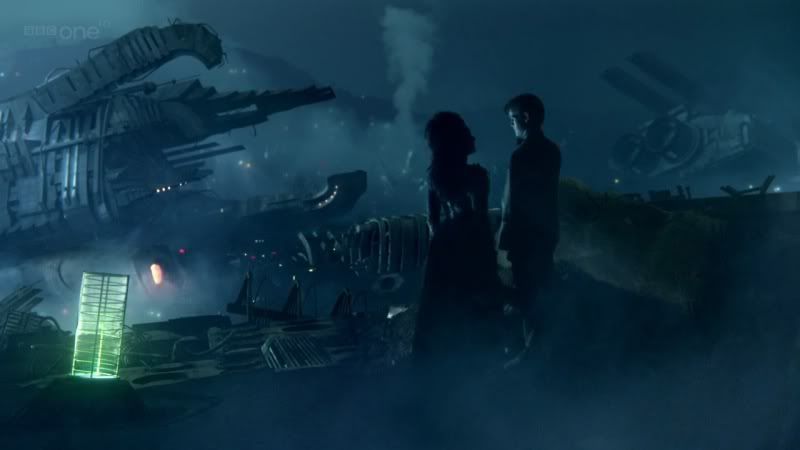
"Who are you?" "It's about time."
There's No Place Like Home:
The Mad Box with a Man
A Review/Analysis of Neil Gaiman's The Doctor's Wife
"Are all people like this?"
"Like what?"
"So much bigger on the inside."
"Goodness. I suppose I shall be taking orders from Dinah next."
But under all this was a pronounced darkness. Shadows looming. Monsters under the bed-type feel. The kiddish look accentuated the darkness, the fear. It reminded me a lot of Alice in Wonderland or Oz (the books, not the film) or Harry Potter. Or the works of Neil Gaiman or Tim Burton or Roald Dahl. A deceptive cuteness or childishness punctuated by the terror and horrors and tragedies of childhood. A psychological darkness, a warping of fantasy and reality, a true look into the brain of the child and the child in the brain of everyone.
That is a passage from my very first review/analysis of Doctor Who under Steven Moffat's reigns, The Eleventh Hour. It was my delighted response to the new mood and style of the series, a mood and style that was right up my literature-degree, folk tale/mythology-obsessed alley. More than a year later, this mood and style has become much more than just a mood; it has become integral to the mythology and themes of the brilliant tale Moffat is telling.
And who better to bring the feel of Neil Gaiman than Neil Gaiman himself?
Needless to say, this fangirl, as a huge Neil Gaiman fan, was looking forward to his episode like it was the second coming of Star Wars.
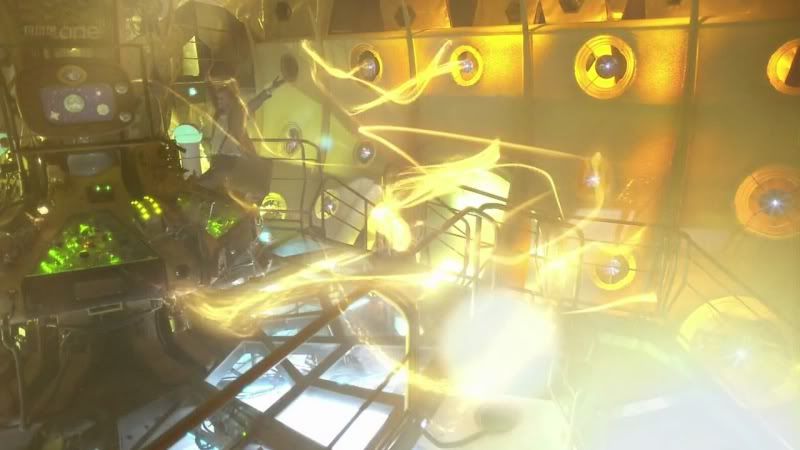
(this was me)
Luckily for me, it was only the greatest episode of Doctor Who ever.
Before, there were episodes I loved that were brilliant storytelling, episodes I'd show to perfect strangers (Blink, Girl in the Fireplace, Gridlock, Midnight). There were episodes that were hilarious fun (Partners in Crime, The Lodger). Episodes that were emotionally resonant, deeply moving (Vincent and the Doctor, Human Nature/Family of Blood). Episodes that were literary and psychologically deep (Amy's Choice). And episodes that got the fangirl juices squeeing (Journey's End, The Last of the Time Lords).
But The Doctor's Wife blew them all out of the water on all fronts.
Holy crap.
I won't do squee posts on how funny it was, how beautiful it was, how moving or clever. The episode speaks for itself on that. No, my job as ever the English teacher, is literary analysis.
And, while watching The Doctor's Wife, I was like, "Son of a bitch. This frigging thing is going to take me weeks to dissect. I'll never get done analyzing this thing."
Get comfy, because here we go.
Who better to anthropomorphosize the TARDIS than the King of Anthropomorphism, Neil Gaiman? It had to be done, and it had to be done in this sixth series [1], and I'm glad that they called in the expert, the author of American Gods, Anansi Boys, Sandman, and Good Omens. The fact that Gaiman is no stranger to the fairy realm (Coraline, Stardust, Neverwhere) or graveyards (The Graveyard Book), brilliantly allows the walking, talking TARDIS to walk and talk. The man wrote Mirrormask [2], so, I mean, come on. Who else could have penned the Doctor's stop-off in Wonderland/Oz in order to have a chat with his spaceship?
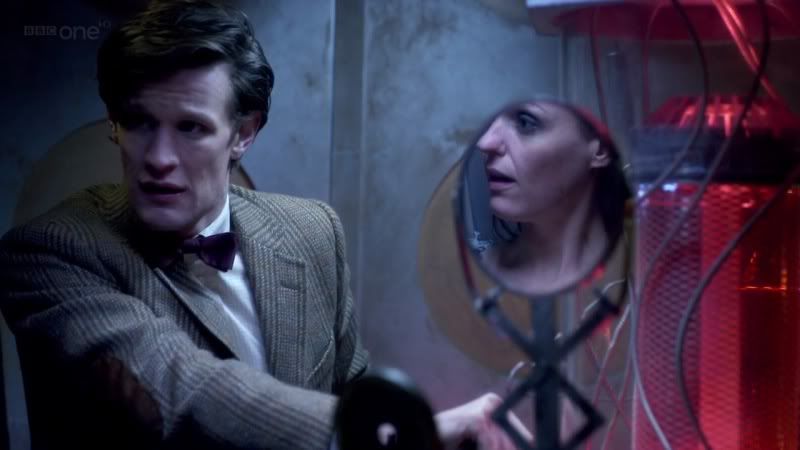
Series Six of Doctor Who (the second Moffat series) has taken the form of a Greek tragedy. It began with the Doctor's death, the revelation of his fate. Every moment since then has been a trip through the mirror, deeper into the magical, psychological fairy realm reminiscent of Wonderland or Oz. Furthermore, the Doctor's adventures have been picaresque, like that of Odysseus, making stops (planets=islands) for individual adventures in order to stave off death [3]. But each adventure is linked by common theme, the common theme that has always been with the Doctor: that of his quest for identity. In series six, though, this quest is a warped quest, one through the mirror, and one in which mirrors are held up to the Doctor.
So, it was only a matter of time before the Doctor's most important companion, his best friend, the greatest love of his life, his other half, the one character that has been with him since the very beginning, the one character that is his doorway into the fairy realm, that defines his very existence, the TARDIS herself, is held up to him as a mirror.

"I've got mail."
The episode starts with the Doctor getting mail. He's in a box, and he gets mail in the form of a box. This is only the start of the layers upon layers upon layers of boxes in this episode [4]. This is an obvious reference to the beginning of the series where the Doctor received TARDIS-blue mail from himself, inviting himself to his own death. This is happening once again, as the Doctor receives mail from a Time Lord (a mirror of himself, representative of that aspect of his identity, his identity as an alien, a god, a Time Lord) once again inviting him to his death. Boxes, the link between the Doctor and his TARDIS, between the body and the soul, contain identity, and they contain life and death, fate.
"Biting's excellent. Like kissing. Only there's a winner."
Furthermore, the box has the serpent's [5] kiss on it. A circle, made up of boxes, on a box [6]. A snake biting its own tail. Biting and kissing her own tail is exactly what the TARDIS will do mere moments after she gets herself mouth [7]. The Doctor and the TARDIS are one being, two halves of the same soul. In a very real sense, the TARDIS is the Doctor's "better half", and he is hers. I will get to more of this in a moment.
"Fear me, I've killed hundreds of Time Lords."
"Fear me, I've killed them all."
But the Doctor is barely concerned with the fact that his better half has lost her soul [8]. Instead, he's consumed with rescuing the lost Time Lords. The Doctor has gone back in time [9], his personal time. He's regressed back to Ten, dealing with Ten's angst and emotional problems, particularly, Ten's identity crisis of being torn between humanity [10] and Time Lord [11]. The Doctor becomes childish and emotional, just as he did as Ten, consumed with his identity as the last of the Time Lords, his identity as the alien, the elevated hero (Christ figure), and even as the monster.

"Look at you. Goodbye. Not goodbye. What's the other one?"
The TARDIS is representative of the Doctor's "alien" nature, being even more alien than he is. As the embodiment of his super power (the ability to play in Time and Space), she is an emblem of his godliness. Literally, she is his key to the heavens. She is the antithesis of anything human or terrestrial [12]. She isn't even linear in Time. Furthermore, in Greek mythological terms, she is his patron goddess. She is Athena to his Odysseus, charging him with a quest, and pushing him towards it. She is a seer, a prophet, a goddess of destiny. In being able to see all of time and space (including the future), she is able to know the Doctor [13] when no one else can. She guides his destiny. Literally, she makes him a hero [14], in every sense of the word. Appropriately, she is also Poseidon to his Odysseus, always keeping him from home.
But, she is his home. This is Dorothy's house in the cyclone traveling from Kansas to Oz. As the Doctor's home, the TARDIS is mirrored in The House. Two talking homes. Boxes in boxes in boxes being anthropomorphic. The House is a masculine, sickly green ball, a perfect contrast to the feminine, heavenly blue box of the TARDIS. The House, like the TARDIS, "picks up strays", providing home and purpose, providing care. Even manipulating. But the thing that makes the House and the TARDIS different, that defines them as opposites, is that the House has a voice. With that voice, he manipulates and destroys all free will. When a god has a literal voice, his subjects lose free will. A truly benevolent god (or teacher, for that matter), provides tests and trials, the journey towards self-discovery, the quest. The House consumes and eats [15], rather than providing comfort and succor, rather than providing this quest outside its doors, it locks them inside. The House's game before killing the "children" Amy and Rory, is like a perverted version of the adventure and "games" that the TARDIS provides her children so that they may find their identities and destinies. Of course, though, the TARDIS also may provide death to her children. Even the Doctor.
The Doctor, though, is just as guilty as the House. He locks Amy and Rory up in the box. This is not where they are supposed to be. They are supposed to be journeying with the Doctor, learning their own identities, helping him learn his. We have stepped through the mirror. It is the TARDIS that is supposed to be locked in the box, not running around free as the Doctor's sidekick. Instead, Amy and Rory face a nightmare into the depths of the psyche: through time corridors that force them to face their greatest fears. Amy once again faces the horror of losing Rory to Time. At one point, Amy is literally in the dark, while Rory is in the light (duality). The Doctor and the House are subjecting them to psychological nightmares, once again stagnating like water in a pond, rather than running forward, like a river.
The House is also a mirror to the Doctor. The House steals the TARDIS. And, in filling his presence and voice in the box, he's supplanted the two halves that normally inhabit it: the Doctor and the TARDIS. This unity is wrong. It is evil. The two are not supposed to be one. The two sides must exist as a duality, as a mirror. The House, in the Doctor's words, is just "so small" because he is one rather than two.
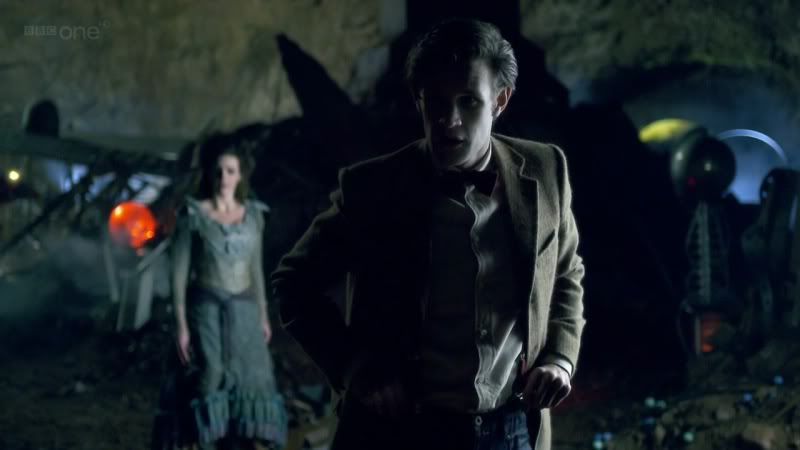
"You have never been very reliable."
"And you have?"
"You didn't always take me where I wanted to go."
"No, but I always took you where you needed to go."
The TARDIS is so much bigger because she is more than just a house, even more than just the Doctor's home. She is at once his home, and also his noble, loyal steed [16]. She is Silver. And, she is Dinah. She is Toto. And only in Oz or Wonderland can she have a voice. "I shall be taking orders from Dinah, next," Alice muses when she follows the bossy white rabbit. Toto, in later books, talks, as all animals in Oz do. The TARDIS is more than just a talking animal, but the comparison is still apt. She is the silent, wise, loyal companion that suddenly is able to speak. This is similar to a great, rich tradition of the archetypical animal at the side of the road who provides great wisdom and guidance (as well as tests) to the questing hero [17]. This is exactly the role of the TARDIS. And this is exactly how she is a mirror to the Doctor. She is the guiding, wise old man/teacher figure to the guiding, wise old man/teacher figure.
Because, although the Doctor is dealing with Ten's issues of being the Christ figure, caught between the heavens and the Earth, he is still the Eleventh Doctor, the teacher/guide, the Doctor that walks amongst human beings, guiding and prompting them. This is the old man trying to deal with the regrets of youth, looking for forgiveness. But, really, he's already come to terms with it because of his role as the teacher and guide. The problem is, he has lost touch with this role in his walk through the mirror at the beginning of the series.
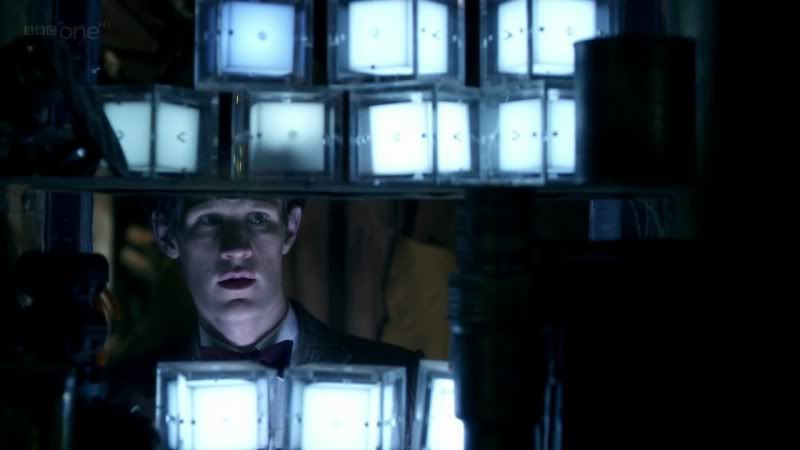
In typical Eleven fashion, he is also the child [18], looking for his lost playmates. He hears their voices, and thinks that they couldn't all fit in the tiny blue cupboard (an obvious reference to the TARDIS which is a blue box that could fit them all). He opens the cupboard and finds all the Time Lords' distress signals, contained in boxes. Their identities are preserved in the boxes. It is a graveyard and they are coffins [19]. This is appropriate because the junkyard is also a graveyard, a graveyard of TARDISes. Coffins, just like the TARDIS, are boxes that contain bodies (or are bodies), and therefore contain identities. And yet, they don't. They do not contain the force, the psyche, the soul that makes us alive. And so, once again, we have layers upon layers of boxes and identities, souls and graveyards.
The Doctor is obviously upset at losing the Time Lords once again, but it is nothing compared to his later emotional reaction. There is a reason. The TARDIS reminds him of his personal history, his past on Gallifrey when they first met, when it all began. And, in doing so, she will remind him of how he was always separate from the Time Lords ("the only one man enough"), how his identity was never really that of a Time Lord. The TARDIS, in reminding him of his identity as an alien (a Gallifreyian, a Time Lord, a heavenly creature), ironically (and appropriately) reminds him of how he was alien from even the aliens. She reminds him of his human nature. Therefore, only with stepping through the mirror, only with talking to your mirror image, can you find out who you are [20].
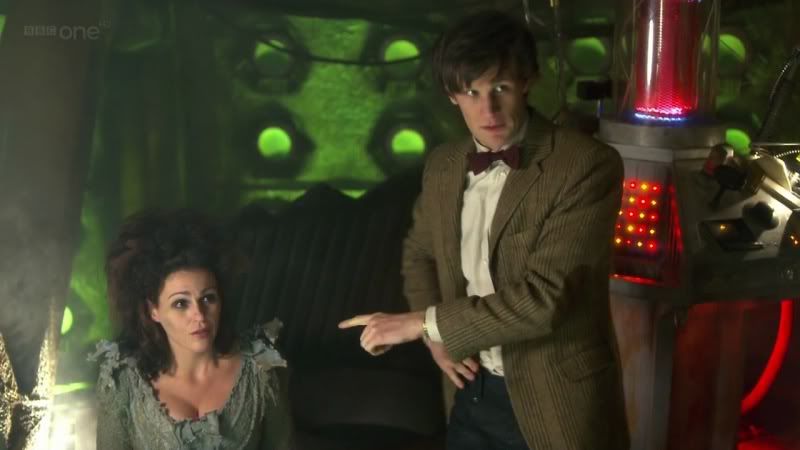
"Don't get emotional because that's when you make mistakes."
"Yes, boss."
Yes, once again, we are through the mirror. Roles have reversed. And with this role reversal, the mirror images can help the Doctor in understanding himself. Once again, Amy is taking the role of being the parent, the guide to the Doctor (once again because she knows his future destiny and death). The TARDIS even quotes Amy; they are both the Doctor's Doctor. This is appropriate; the old man teacher-figure always gains wisdom, guidance, and redemption from both their own guide/teacher (the TARDIS), and also from their students (the companions) [21].
The TARDIS isn't just the wise old woman. The TARDIS isn't just a Greek goddess guiding the hero to destiny. She isn't just a talking animal providing wisdom. And that is because, unlike any of those things, she usually doesn't talk. The TARDIS is much more a silent force on the Doctor's identity and quest. And therefore, she is much more like God with a capital G. The big God. And the Doctor's conversations with her in this episode are very much that of a human talking to their divine creator.
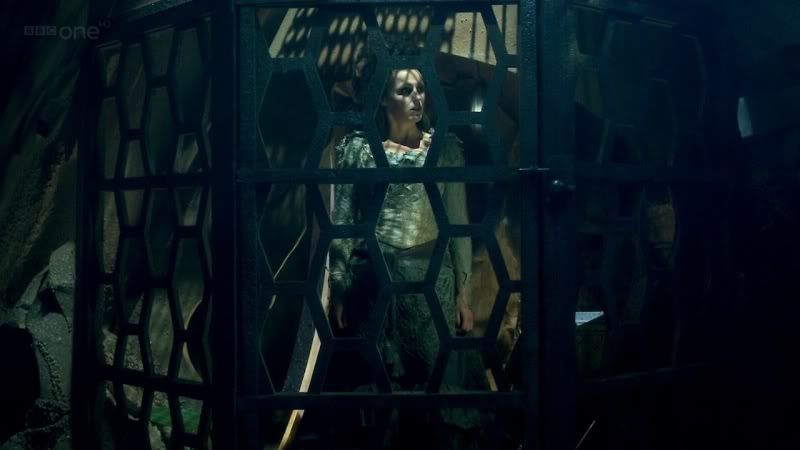
"Patchwork people.
You've been repaired and patched up so often
I doubt there's anything left of what used to be you."
But if she has created the Doctor, he has also created her [22]. Their identities are completely dependent upon each other. Literally, they are two halves of the same being. When the TARDIS is placed in a human body, she looks and acts like the bride of Frankenstein [23]. In fact, she keeps trying to say that she's "alive" [24]. I loved this for two reasons.
First of all, I noted back in my first review of The Eleventh Hour that Matt Smith's performance was reminiscent of Frankenstein's monster (an alien in a "human suit", according to Amy). It is only appropriate, then, that the Doctor's bride act the same as he did when he got himself a new body. (They ever seem to regenerate in the same golden light.) Both act very much like divine, alien souls in new, human, alien-to-them bodies. Thus we have the disconnect between the soul and the body. This disconnect is echoed over and over throughout the episode. The TARDIS is disconnected from her body (the box). The Doctor is disconnected from his soul (in losing the TARDIS). And this disconnection between soul and body means a loss, a split (duality), of the identity. But it also means, ironically, the deep connection between the body and the soul, how identity is the place where the body and soul meet [25]. In every sense, the TARDIS (both in her human body and in the box) is a symbol of identity, particularly, of the psyche. She has that brilliant line about people being bigger on the inside. The body, just like the TARDIS box, is intrinsic to identity. It contains the soul and all its many caverns. It is the means by which the soul explores, impacts, and is impacted by the world. It defines the soul.

"Thief! Thief! You're my thief!"
"Why am I a thief? What have I stolen?"
"Me. Are you going to steal me? You have stolen me.
You are stealing me. Tenses are difficult aren't they."
Secondly, I loved the comparison with the bride of Frankenstein due to the symbolism and nature of "the bride". Brides, from Donna Noble to Amelia Pond, have been integral to the mythology of Doctor Who, as symbols of feminine power, particularly, unrealized feminine power. Just as animal brides represent the wilderness, the call of the wild away from civilization, Donna and Amy represent the Doctor's call to adventure, the embodiment of female fantasy, the female desire to run away from domestic matters, from civilization, to "see the universe", and to discover one's identity. Thus brides are a mirror [26] to the Doctor's own quest. Now we know that there was a runaway bride before either Amy or Donna popped onto the TARDIS: the TARDIS herself. The Doctor's bride.
Furthermore, as the TARDIS is a "talking animal", this invokes the tradition of animal bride fairy and folk tales. Tales where brides change their form, animals turn human and humans turn to animals. This transplanting of the soul/psyche into changing bodies is exactly what occurs with the TARDIS in this episode, further punctuating that theme of the connection between identity and body. Also, many animal bride tales (such as selkie tales) concern a husband who steals the bride's skin so that she may not return to the wilderness [27]. This is of course reflective of the Doctor's supposed stealing of the TARDIS [28]. The beautiful, brilliant catch, of course, is that the TARDIS confesses that she stole him. Thus, in brilliant mirroring, in going through the looking glass into Oz, we learn of the greatest mirror of all: that the Doctor seduced the TARDIS and stole her and that the TARDIS seduced the Doctor and stole him [29].
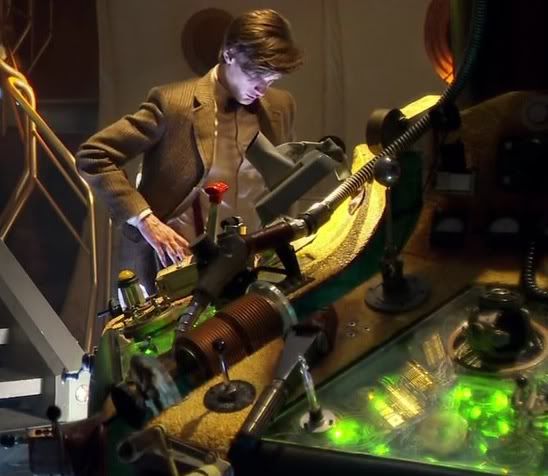
"Ever wonder why I chose you all those years ago?"
"I chose you. You were unlocked."
"Of course I was. I wanted to see the universe.
So I stole a Time Lord and I ran away.
And you were the only one man enough."
And why did she steal him? To see the universe. To adventure and break the Time Lord rules and save worlds and make people better. The same reason he stole her. And to see the universe is to quest. To quest is to find one's identity. Who else would need an identity more than two creatures that don't have names: the Doctor and the TARDIS.
"Sorry, do you have a name?" "700 years. Finally, he asks."
The "sexy" name joke is so very much the "nobody" name joke of The Odyssey. And, if your name is "nemo" (nobody), you have no identity. It is appropriate, then, that the TARDIS has such trouble introducing herself to the Doctor. Both his and her identities are split across time, are hidden in time, have yet to be realized. Also, "Nobody" can mean no body, which is appropriate for both the TARDIS and the shape-changing Doctor [30]. No name, no body, no identity. Name, body, identity are all one and the same.
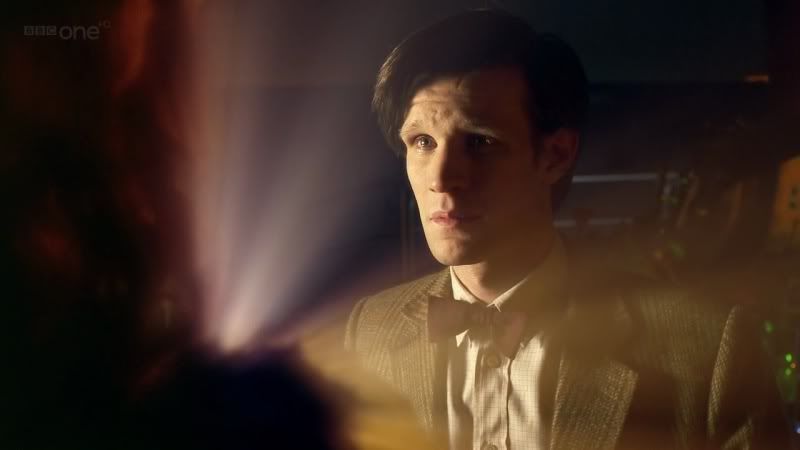
"You really not know me? Just because they put me in here?"
As the Doctor realizes that he's chasing ghosts, as he loses the Time Lords all over again, he comes back down to earth. Just as Amy says, he becomes emotional (granted, his emotions are alien to him), and that is to say, more human. Which is appropriate, as his TARDIS is also becoming more human [31]. But, this time, it is the TARDIS that is the weird unknown, the one with the unrecognizable body, with the mysterious identity. We are through the mirror, and that mirror is being held up to the Doctor. But the Doctor doesn't recognize her, just as he once didn't recognize his own image (in The Eleventh Hour). Just because they put her soul in a new body, he doesn't know his TARDIS. This ironic because the Doctor's soul changes bodies [32] every couple of years [33], and yet expects people to still recognize him. This is also the very reason why the Doctor can't recognize the TARDIS; he doesn't know his own identity, how could he possibly recognize the TARDIS, an extension of his identity, in a new form?
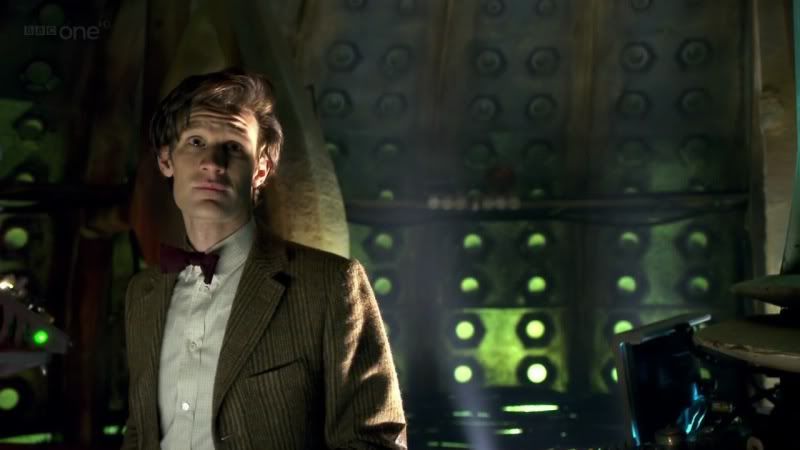
"I was already a museum [34] piece when you were young… The first time you touched my consol, you said--"
"I said you were the most beautiful thing I'd ever known."
"Then you stole me. And I stole you…
what makes you think I'd ever give you back."
But, with this split between the TARDIS' soul and her body, between her and the Doctor, we are allowed duality. And, with duality, we are allowed mirrors. And, therefore, we are able to examine the relationship between the Doctor and his TARDIS, between the captain and his ship, between the knight and his steed, between man and god, between the man and his superpower. The Doctor cries that he's "the mad man with a box without a box!", and thus, he's powerless. But he's not. There's a reason that the Doctor and his TARDIS survive and destroy the House when other Time Lords failed and other TARDISes were left to rot in the graveyard. They are more than just a Time Lord or just a TARDIS. I doubt that many other TARDISes, once they got a body, ran out to make out with their Time Lord. The Doctor and his TARDIS are more than just bodies in a box, and more than just two separate creatures. They are two halves of a whole.
"Wouldn't it be great to talk,
even when you're stuck inside the box?"
"I'm not made that way.
I exist across all of space and time
and you talk and run around and bring home strays."
At the beginning of the episode, the Doctor says that he's going to get rid of the warning lights because they're always going off. He's not listening to his TARDIS. By the end, he's talking to her, and, more importantly, he's listening to her. They have come together, two halves no longer split. The Doctor and the TARDIS create a new TARDIS, appropriately in the form of a spinning ball (circle). At first, the Doctor thinks he's failed, but the TARDIS, in true "you've had them all along" ruby slipper fashion, turns away from her own (literal) mirror reflection, turns towards her (literary) mirror reflection, the Doctor, and says, "You've got what you've always had, you've got me." Of course he does.
"It's always you and her after the rest of us are long gone.
Boy and his box off to see the universe."
"You say that like it's a bad thing. Best thing there is."
The episode ends with the Doctor building Amy and Rory a new bedroom (without bunk beds), and Rory asking where the Doctor's bedroom is. The implication, obviously, is that his bedroom is right there, the command room, right beside his wife, the TARDIS. The TARDIS is "back in the box" [35], back in her "body house"; "you took her from her home, but now she's back in the box again, and she's free. " Once again, she has power and identity. Ironically, she has lost her voice. Just as she is meant to. One is not allowed to talk to oneself. One must discover oneself.
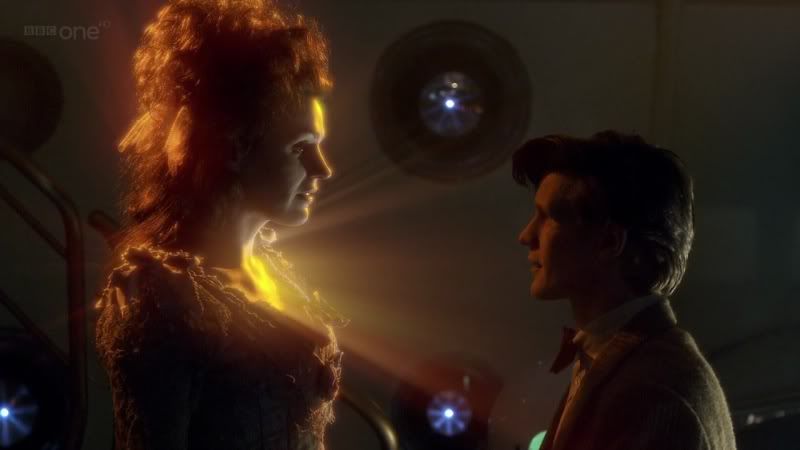
"There's something I didn't get to say to you."
"Goodbye."
"No. Just wanted to say hello.
Hello, Doctor. It's so very, very nice to meet you."
The TARDIS and the Doctor are two halves of a soul on the journey toward identity. But they have already discovered one aspect of that identity: they are one and the same, body and soul. Now that they have met, they know each other. She is the Doctor's TARDIS; he is the TARDIS' Doctor.
"What do you think, dear,
where should we take the kids this time?"
[1] Motifs, themes, and symbols throughout the fifth and sixth series have been leading us right up to this.
[2] Mirrors being our operative theme/motif of series 6.
[3] I call it "ponding", as he's running off with the Ponds (stagnant water, and a stagnant water that can act as a mirror) rather than facing the flow of Time.
[4] It very nearly made my poor literary head cave in.
[5] And, holy crap, I'm not going to go into all the symbolism that a serpent has. My trusty Penguin Dictionary of Symbols has ten pages on the serpent. I'll only repeat one of the title headings: The Serpent as Healer and Seer. Um, the Doctor, cough cough.
[6] This is an obvious reference to the Pandorica, which was a box with a circle--made up of boxes--on it. The reference to the Pandorica is deeply apt, as it was the culmination of series five's theme of boxes containing identity (the Pandorica containing the Doctor's monster side, the TARDIS containing his heroic side). I'm not going to repeat everything I've said in my analysis of series five, but I will repeat that series five firmly established the deep interconnectedness of the Doctor's identity and the TARDIS.
[7] I mean, come on. I was waiting for them to do a lot more than that from the very second she got a body.
[8] And, when she loses hers, he's lost his. When her identity is hijacked and altered, so is his. When identity (soul) is split from body, we have duality, literally, in the manifestation of the married couple: the Doctor and the TARDIS. With duality, we have mirrors.
[9] Once again, we have the theme of Time being psychological, being linked to memory, and therefore linked to identity.
[10] He distances himself from humanity, locking up Amy and Rory in a box.
[11] This is why I am not surprised to see Ten's console make a guest appearance.
[12] And yet, as always is the case with extremes, particularly in duality, she is also his key to Earth. She is the means by which the god may walk the earth with humans. She is his mortal body.
[13] Once again, that overlapping of Time with psychology with identity.
[14] She is his "God, Time, Fate, or whatever", in the words of my favorite show as a child, Quantum Leap.
[15] An interesting corruption of Hansel and Gretel's Gingerbread House. The House, though, consumes, rather than being consumed. But this is appropriate. In the fairy tale, the Gingerbread House, and the witch it contains, are a perversion of maternal love; rather than providing home and food, it threatens to consume children, just as the House does.
[16] It is appropriate that the previous episode concerned a pirate ship and the series opener concerned Apollo 11. Ships have become a motif of this series.
[17] Heroes that are always questing to learn who they are.
[18] And he has become much more childlike this series.
[19] The Doctor, of course, will end up needing a coffin, too. Remember, we are always moving towards his death this series. But, ironically, the Doctor didn't get a coffin; his companions burned his body. Which makes us think: what happened to 1100-year-old-11th-Doctor's TARDIS? Because we can never have one without the other. Thus, the TARDIS is already related to coffins, particularly the Doctor's.
[20] This is why Ten's command room will be deleted once again. The Doctor has moved beyond this identity crisis.
[21] This is Obi-Wan, between Qui-Gon and Anakin.
[22] "You have any idea how childish that sounds?" "You are not my mother." "And you are not my child." Except, she sort of is. Except, he sort of is her parent. There is very much a Pygmalion vibe going on here.
[23] The Frankenstein motif is also mirrored in the "patchwork people" Auntie and Uncle, made out of bits and pieces of Time Lords. The Uncle has "the eyes of a twenty-year old". Just like the Doctor. Their relationship with their House is very much a warped mirror of the Doctor's relationship with his TARDIS. Also mirrored with the Doctor, though, is their relationship with their own Frankenstein bodies, their patchwork parts, which are absolute echoes of Oz, which is populated with living patchwork people (the Patchwork Girl, for one), inanimate objects that think, feel, talk, and have identities that are deeply connected to their patchwork bodies, even though their bodies are alien. My most favorite is the Tin Man, whose human body he hacked off due to an enchanted axe. When he goes out to find the munchkin girl he once loved, he finds her happily married to a man made out of the body parts of both him and another cursed Tin Man. In Oz, as in all fairy tales, including Doctor Who, dismemberment (regeneration is a form of this) is about a change in identity, a form of rebirth, a form of death. Thus, the interconnectivity of the physical body and the psychological soul.
[24] THIS! On one level, the inanimate object (the TARDIS) is alive. On another level, it is a dead body (Idris) that is alive. The TARDIS punctuates this beautifully in her speech ("Alive isn't sad." "It is when it's over."). Thus the mirror images of death and life exist in one. The beginning and end (time) exist in one. Mirror images. And this is fitting because the Doctor's death and his life exist in one during this series. Each episode is his little carpe diem stand against death and the end.
[25] Would Eleven be Eleven in any other body? Would he be Eleven in any other suit? Would the TARDIS be the TARDIS if she wasn't the iconic blue police box? Of course not. That tie, that tweed suit, that face, that bluest blue, they define them as much as their personalities.
[26] And vital to, as they are the means by which the Doctor realizes his own identity. By guiding brides down the very long walk to the altar, the Doctor achieves his own identity as the archetypical wise old man-teacher-guide. He does this for his companions, as well as the TARDIS, his own bride, who both, in turn, do it for him.
[27] With, of course, the implication that the selkie or animal bride, in providing the temptation (seduction), also gives permission to be stolen.
[28] The TARDIS' shouts of "thief! thief!" are perfect references to the Harp's cries when she's stolen from the giant by Jack, another anthropomorphic, magical "object".
[29] It is beautifully ironic that, when the Doctor meets the TARDIS in her human body, he runs away from her. Oh, mirrors.
[30] Which again reminds me of Alice in Wonderland. When Alice changes size or shape during the day (time), she loses her perception of her identity, and can't answer the caterpillar's question, "Who are you?"
[31] With humanity, of course comes mortality. Death for both the Doctor and the TARDIS.
[32] Just like the TARDIS does, inside and out.
[33] And when the Doctor changes bodies, his soul changes, as does his identity. Box and soul, body and psyche, are deeply linked.
[34] Museums were a motif of the fifth series. Museums are boxes of Time, containing relics of history. And, in so doing, they are boxes of identity, containing the soul of history and civilization. In other words, museums are the TARDIS.
[35] Again, another Pandora reference. The magical female forces, the power and magic of time and space, are back where they belong, back in her body.